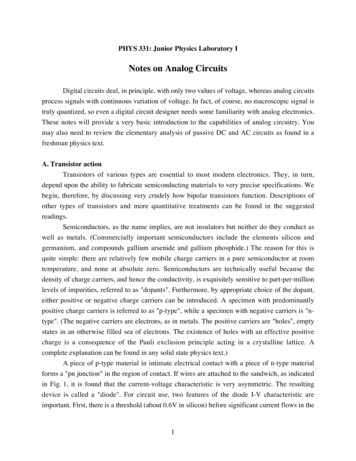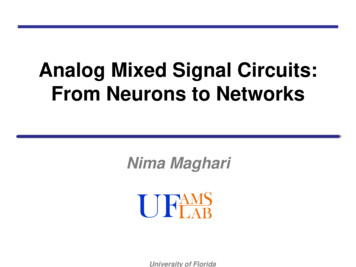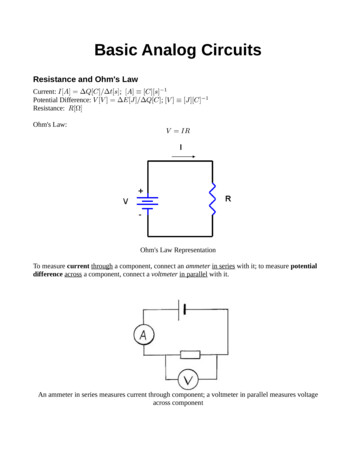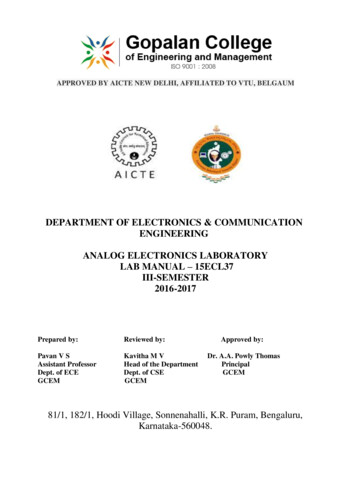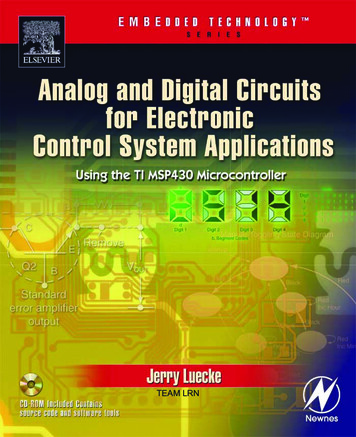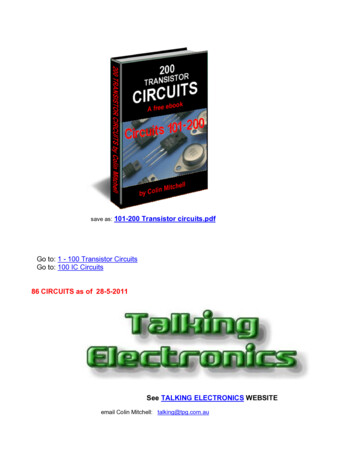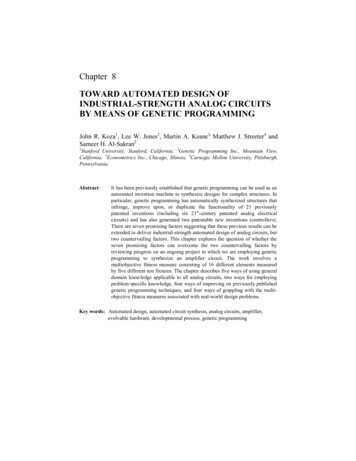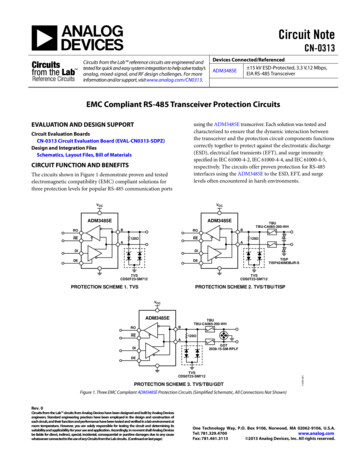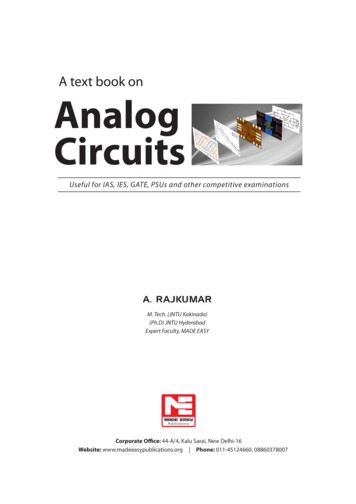
Transcription
AnalogCircuitsUseful for IAS, IES, GATE, PSUs and other competitive examinationsA. RAJKUMARM. Tech. (JNTU Kakinada)(Ph.D) JNTU HyderabadExpert Faculty, MADE EASYCorporate Office: 44-A/4, Kalu Sarai, New Delhi-16Website: www.madeeasypublications.org Phone: 011-45124660, 08860378007
MADE EASY PublicationsCorporate Office: 44-A/4, Kalu Sarai, New Delhi-110016Website: www.madeeasypublications.org Phone: 011-45124660, 08860378007E-mail: infomep@madeeasy.inA text book on Analog Circuits Copyright, by MADE EASY Publications.All rights are reserved. No part of this publication may be reproduced, stored in or introduced intoa retrieval system, or transmitted in any form or by any means (electronic, mechanical, photocopying, recording or otherwise), without the prior written permission of the above mentionedpublisher of this book.First Edition: 2012Reprint: 2013Reprint: 2014Reprint: 2015Reprint: 2016Reprint: 2019Typeset at: MADE EASY Publications, New Delhi-110016
Dedicated toMy WifeA. Smithawho believes, inThe best teacher teaches from the heart,. . . . not from the book . . . .
PREFACEI have great pleasure in writing the book of core subject of Electronics Engineering viz.Analog Circuits. A thorough understanding of the concepts developed in this book will preparethe reader for more advanced course on the subject. The entire syllabus of Analog circuits ispresented in a simple and lucid style to make it comprehensible to an average student. Thistext book has been written to meet the requirements for the students of B.E./B.Tech., ECE, EEE,EIE.In this book, I have tried to present the approach for competitive examinations like GATE,IES and IAS. While teaching various categories of students, I understood that, it becomes veryeasy for the students when things are explained by going through the fundamentals. So in thepresent book, I tried to explain most of the topics through the basics. The Questions withSolutions which already appeared in competitive examinations like GATE, IES are incorporatedin each chapter.First, I would like to thank Mr. B. Singh (Chief Managing Director, MADE EASY Group) forgiving me the opportunity for writing the text book. His constructive suggestions and supporthelped me a lot.I express my heartfelt regard and gratitude to my teacher Dr. Srinivas Rao from whom Ihave learnt the subject matter and which gave me inspiration to write this book.I would also like to thank my H.O.D. Dr. Koteswara Rao and Principal Dr. Chinna KeshavaRao (CBIT), Mr. Sudarshan Reddy (Associate Prof. in CBIT) who always inspire me in disciplineand hard work.A special thanks to Mr. Sai Prasad who always, encourages me and gave me the firstopportunity to teach for competitive exams.I express my sincere gratitude to my favorite Sir, Mr. Prem R. Chadha, friends M.V. KiranKumar, Ramana Reddy, Krishna Kumar, Jagan, Krishna who always direct me in a right path.Last but not the least, I also thank MADE EASY staff especially Vinod Kumar andMd. Asim who put their sincere efforts to develop this book in time.Any comments and suggestions for the improvement of this book will be thankfullyacknowledged and incorporated in the next edition.A. Rajkumar
CONTENTS12BJT Biasing and Thermal Stabilization1.1Operating Point and DC Load Line 21.2Temperature Dependence on Transistor Parameters 51.3Stability Factor 61.4Biasing Techniques 71.5Fixed Bias Circuit 71.6Collector to Base Bias 81.7Voltage Divider Bias or Self Bias 101.8Bias Compensation by Diode 121.9Bias Compensation by Thermistor 121.10Bias Compensation by Sensistor 121.11Thermal Run away 13Small Signal Analysis of BJTLow Frequency Analysis2.1Introduction 322.2Two Port Network 322.3Hybrid Model of BJT 342.4Hybrid Model in Different Configurations 342.5Typical Values of H-Parameters 352.6Conversion Formulas of H Parameters in Different Configuration 352.7Transistor Amplifier Analysis Using Exact Model 352.8Transistor Amplifier Analysis Using Approximate Model 38High Frequency Analysis2.9Introduction 412.10Hybrid-p Model 412.11Typical Values of Hybrid-p Parameters 422.12Expressions for Hybrid-p Parameters 432.13Variation of Hybrid p Parameters With Ic, VCE and Temperature 482.14Common Emitter Short Circuit Current Gain 482.15High Frequency Current Gain with Resistive Load 50Frequency Response of an Amplifier2.16Low Frequency Range 522.17High Frequency Range 522.18Midband Range 522.19Application of Bodeplot in Frequency Response of Amplifier 53
Page viii 345A Text book on Analog CircuitsFeedback Amplifiers3.1Introduction 663.2Limitations of Basic Amplifier 663.3Feedback Principle 663.4Classification of Amplifiers 673.5General Theory of Feedback 693.6Concept of Positive Feedback and Negative Feedback 713.7Advantages of Negative Feedback Amplifiers 723.8Topologies of Feedback 763.9Voltage Series Feedback 793.10Voltage Shunt Feedback 793.11Current Series Feedback 813.12Current Shunt Feedback 823.13Method of Analysis of a Feedback Amplifier 83Oscillators4.1Introduction 964.2Types of Oscillators 964.3Essentials of Transistor Oscillator 974.4Barkhausen Criterion 984.5RC Phase Shift Oscillator 994.6Wien Bridge Oscillator 1034.7Comparison of RC Oscillators 1054.8LC Oscillators 1064.9Hartley Oscillator 1074.10Colpitts Oscillator 1094.11Clapp Oscillator 1114.12Crystal Oscillator 112Power Amplifiers5.1Introduction 1245.2Difference Between Voltage Amplifier and Power Amplifier 1245.3Power Amplifiers 1265.4Power Amplifier Classes 1265.5Comparison of Amplifier Classes 1285.6Class-A Power Amplifier 1285.7Distortion in Amplifiers 1335.8Class-B Power Amplifier 1345.9Class-B Push Pull Amplifier 1365.10Complementary Symmetry Class-B Amplifier 140
Content 67Page ix5.11Comparison Between Push Pull and Complementary Symmetry 1405.12Cross Over Distortion 1415.13Class-AB Amplifier 1415.14Safe Operating Area (SOA) For a Transistor 1425.15Thermal Analogy of Power Transistors 1435.16Class-C Power Amplifier 1445.17Class-D Amplifiers 1455.18Class-S Power Amplifier 146Multistage Amplifiers6.1Introduction 1546.2Characteristics of Cascaded Amplifier 1546.3Gain in Decibels 1556.4Selection of an Amplifier Configuration For Cascade Connection 1566.5Methods of Coupling in Multistage Amplifiers 1566.6RC Coupled Amplifiers 1576.7Transformer Coupled Amplifier 1586.8Direct Coupled Amplifiers 1606.9Comparison of Different Coupling Techniques 1616.10Rise Time-bandwidth Relation 1616.11Cascode Amplifier (CE-CB) 1636.12Darlington Pair (CC-CC) 1636.13Bootstrap Emitter Follower 1646.14Millers Theorem 1656.15Effect of Cascading on Bandwidth (identical stages) 1666.16Effect of Cascading on Bandwidth (non identical stages) 168Linear and Non Linear Wave ShapingLinear Wave Shaping7.1Introduction 1767.2High Pass RC Circuit 1767.3RC Differentiator 1777.4Sinusoidal Input 1787.5Response of Step, Pulse, Square, Ramp, Exp. for High Pass ckt 1797.6Low Pass RC Circuit 1807.7Low Pass RC Circuit as Integrator 1817.8Sinusoidal Input 1817.9Response of Step, Pulse, Square, Ramp and Exp. for Low Pass ckt 183Non Linear Wave Shaping7.10Clippers 1847.11Shunt Clipper Models 1847.12Series Clipper Models 1897.13Clipping at Two Independent Levels 1957.14Clamping Circuits 199
Page x8 A Text book on Analog CircuitsRectifiers, Filters and Voltage RegulatorsRectifiers8.1Introduction 2168.2Rectifier Parameters8.3Half Wave Rectifier 2178.4Full Wave Rectifier 2228.5Bridge Rectifier 226216Filters8.6Introduction 2278.7Capacitor Filter 2288.8Inductor Filter 2318.9L Section Filter 2348.10p Section Filter 2358.11Bleeder Resistor 236Voltage Regulators98.12Introduction 2368.13Block Diagram of Power Supply 2368.14Load Regulation 2378.15Line Regulation 2378.16Series Voltage Regulator 2378.17Shunt Voltage Regulator 2388.18Limitations of Series and Shunt Voltage Regulators 238Operational AmplifiersDifferential Amplifiers9.1Introduction 2489.2Differential Amplifier 2489.3Circuit Configurations 2499.4Circuit Diagrams 2509.5Operating Point (Q) for a Differential Amplifier 2529.6Practical Design Problems in Differential Amplifiers 2539.7Swamping Resistor Technique 2549.8Constant Current Source Circuits 2559.9Current Mirror Circuits 2579.10Common-Mode Voltage Gain 2609.11Differential Amplifier With Active Load 262Operational Amplifiers9.12Block Diagram of Operational Amplifier 2639.13Symbol Representation of Op-Amp 263
Content 9.14Equivalent Circuit of an Op-Amp 2649.15Ideal Voltage Transfer Characteristics 2649.16Pin Diagram of 741 IC 2659.17Op-amp Characteristics 2659.18Importance of Negative Feedback in Op-Amp 2709.19Virtual Ground 271Applications of Operational Amplifier9.20Inverting Amplifier 2719.21Non-Inverting Amplifier 2729.22Phase Shifter 2739.23Voltage Follower 2739.24Differential Amplifier 2749.25Subtracter 2759.26Inverting Adder 2759.27Non Inverting Adder 2769.28Current to Voltage Converter 2779.29Voltage to Current Converter 2789.30Voltage to Current Converter (with load) 2789.31Op-Amp Integrator 2799.32Op-Amp Differentiator 2809.33Precision Rectifiers 2819.34Current Amplifiers 2859.35Instrumentation Amplifier 2869.36Voltage Limiters 2879.37Log Amplifiers 2899.38Anti Log Amplifiers 2899.39Analog Multiplier 2909.40Analog Divider 2919.41Peak Detector 2929.42Sample and Hold Circuit 2929.43Op-amp Comparator 2939.44Schmitt Trigger 2959.45Astable Multivibrator (free-running oscillator) 2979.46Triangular-Wave Generator 2989.47Monostable Multivibrator (pulse generator) 299Active Filters9.48Introduction 3019.49Classification of Active Filters 3019.50Butterworth Filter 3039.51First Order Low Pass Butterworth Filter 3049.52First Order High Pass Butterworth Filter 3069.53Band Pass Filters 309Page xi
Page xii A Text book on Analog Circuits9.54Band Stop Filter 3139.55All Pass Filter 315555 Timer109.56Introduction 3189.57555 Timer Pin Configuration 3189.58Block Diagram of 555 Timer 3199.59555 Timer as Monostable Multivibrator 3209.60555 Timer as Astable Multivibrator 323FET Biasing and Small Signal AnalysisFET Biasing10.1Introduction 37010.2DC-Load Line and Bias Point 37010.3Fixed Bias Circuit 37210.4Self Bias 37310.5Voltage Divider Bias 374Small Signal Analysis1110.6Introduction 37610.7Common Source Bypass JFET Amplifier 37710.8Common Source Unbypass JFET Amplifier 37910.9Common Drain JFET Amplifier 38110.10 Common Gate JFET Amplifier 38210.11 Comp. Between CS Bypass, CS Unbypass, CD, CG Amplifiers 385Multivibrators and Time Base GeneratorsMultivibrators11.1Introduction 39411.2Bistable Multivibrator 39511.3Schmitt Trigger 39711.4Mono Stable Multivibrator 39911.5Astable Multivibrator 401Time Base Generators11.6Introduction 40411.7Sweep Voltage 40411.8Methods of Generating a Time Base Waveform 40511.9Exponential Sweep Circuit 40611.10 UJT Sweep Generator 40611.11 Bootstrap Sweep Generator 40811.12 Miller Sweep Circuit 410
9.39 Analog Multiplier 290 9.40 Analog Divider 291 9.41 Peak Detector 292 9.42 Sample and Hold Circuit 292 9.43 Op-amp Comparator 293 9.44 Schmitt Trigger 295 9.45 Astable Multivibrator (free-running oscillator) 297 9.46 Triangular-Wave Generator 298 9.47 Monostable Multivibrator (pulse generator) 299 Active Filters 9.48 Introduction 301

